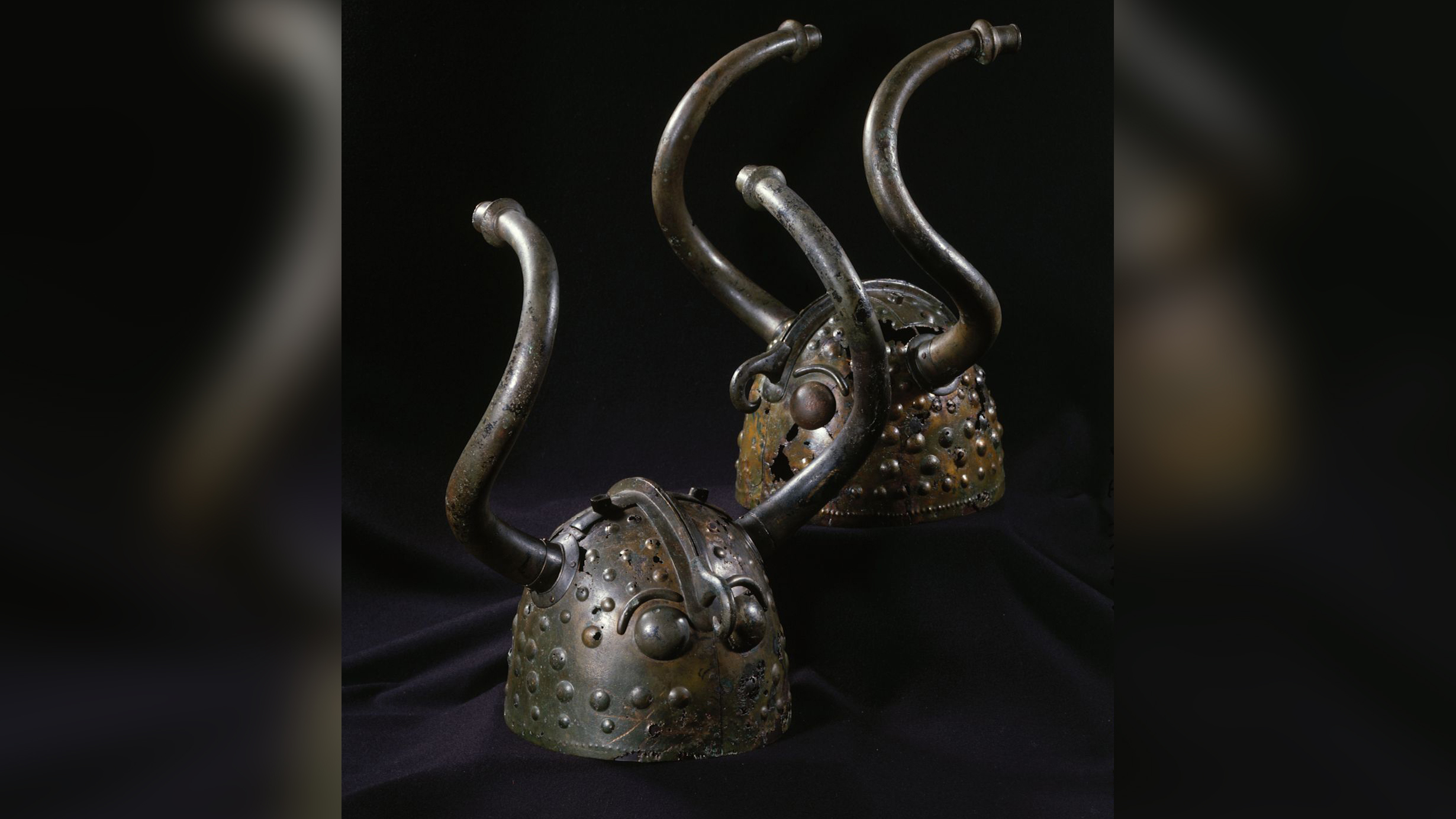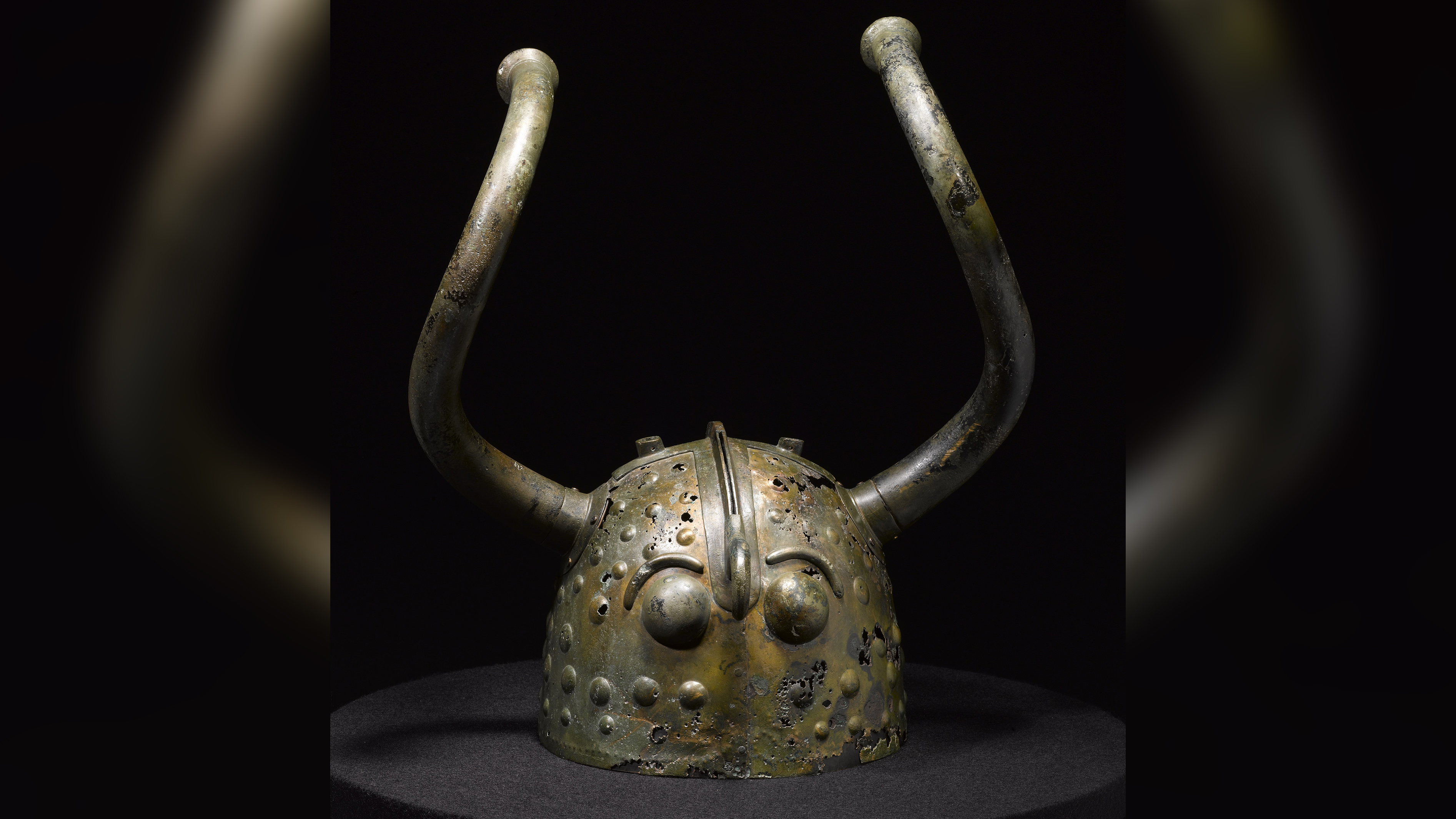Horned 'Viking' helmets were actually from a different civilization, archaeologists say
Spectacular helmets worn by Bronze Age leaders as power symbols.

Two spectacular bronze helmets decorated with bull-like, curved horns may have inspired the idea that more than 1,500 years later, Vikings wore bulls' horns on their helmets, although there is no evidence they ever did.
Rather, the two helmets were likely emblems of the growing power of leaders in Bronze Age Scandinavia.
In 1942, a worker cutting peat for fuel discovered the helmets — which sport "eyes" and "beaks" — in a bog near the town of Viksø (also spelled Veksø) in eastern Denmark, a few miles northwest of Copenhagen. The helmets' design suggested to some archaeologists that the artifacts originated in the Nordic Bronze Age (roughly from 1750 B.C. to 500 B.C.), but until now no firm date had been determined. The researchers of the new study used radiocarbon methods to date a plug of birch tar on one of the horns.
Related: 1,200-year-old pagan temple to Thor and Odin unearthed
"For many years in popular culture, people associated the Viksø helmets with the Vikings," said Helle Vandkilde, an archaeologist at Aarhus University in Denmark. "But actually, it's nonsense. The horned theme is from the Bronze Age and is traceable back to the ancient Near East."
The new research by Vandkilde and her colleagues confirms that the helmets were deposited in the bog in about 900 B.C. — almost 3,000 years ago and many centuries before the Vikings or Norse dominated the region.
That dates the helmets to the late Nordic Bronze Age, a time when archaeologists think the regular trade of metals and other items had become common throughout Europe and foreign ideas were influencing Indigenous cultures, the researchers wrote in the journal Praehistorische Zeitschrift.
Sign up for the Live Science daily newsletter now
Get the world’s most fascinating discoveries delivered straight to your inbox.

Horned helmets
In 1942, a man cutting peat for fuel found broken pieces of the helmets, according to the Danish Ministry of Culture.
When the muddy helmet fragments were first discovered, the man who found them thought they were bits of buried waste, so he set them aside. Later, a foreman noticed the fragments and stored them in a shed for later examination. Later examinations by archaeologists from the National Museum of Denmark showed that the "buried waste" fragments were actually parts of two bronze helmets decorated with curved horns. When excavating the peat pit, researchers also found the remains of a wooden slab that one of the helmets seemed to have stood on, which suggested they had been deliberately deposited in the bog.
But metal can't be reliably dated, and further research suggested the wooden slab might have been placed in the bog earlier than the helmets. It wasn't until 2019 that one of Vandkilde's colleagues spotted the birch tar on one of the horns when she was preparing to take new photographs of the helmets at the National Museum of Denmark.
"She noticed that there was primary organic material in the horns and spoke to a colleague at the National Museum responsible for the collection, and they agreed to send a sample for absolute dating," Vandkilde said.
Previously, any information about the helmets was based on their typology — the style they were made in and any symbols they were decorated with. But the new date is based on the radioactive decay of the isotope carbon 14, which can determine when the organic matter originated. This method let archaeologists pinpoint when the helmets were created and theorize their purpose, she said.
"Typology is quite often a good first step, chronologically speaking, but it is very important when we can have absolute dates, as we can with carbon 14," Vandkilde said. "We now know with this new date that the helmets were deposited in the bog, perhaps by someone standing on a wooden platform, around 900 B.C."
Sun symbolism

As well as their prominent horns, the Viksø helmets are adorned with symbols meant to look like the eyes and beak of a bird of prey; plumage that has since eroded was likely stuck into the ends of the horns with birch tar, and each helmet also may have had a mane of horsehair.
Both the bulls' horns and the bird of prey were probably symbols of the sun, as similar iconography from the time has been found in other parts of Europe, such as on the Mediterranean island of Sardinia and in southwest Iberia. "It's certainly not coincidental — there must have been some sort of connection there," Vandkilde said.
It's possible that the symbology of sun worship may have reached Scandinavia along a sea route, from the Mediterranean and along the Atlantic coast, that was used by the seafaring Phoenicians for trade after about 1000 B.C., "independent of the otherwise flourishing transalpine trading route," the researchers wrote.
There is no sign that the Viksø helmets were ever used for war, which was usually carried out in Bronze Age Scandinavia with only rudimentary helmets or no helmets at all. "They were never used for battle," Vandkilde said.
Instead, leaders probably wore the helmets as symbols of authority at a time when the region was becoming more politicized and centralized, she said.
"There are many signs of this, and our new dating of the Viksø helmets actually suits this very well — this picture of centralization and the importance of political leadership," she said. "And those leaders must have used religious beliefs and innovative traits, like the horns, to further their power."
Originally published on Live Science.
Tom Metcalfe is a freelance journalist and regular Live Science contributor who is based in London in the United Kingdom. Tom writes mainly about science, space, archaeology, the Earth and the oceans. He has also written for the BBC, NBC News, National Geographic, Scientific American, Air & Space, and many others.










